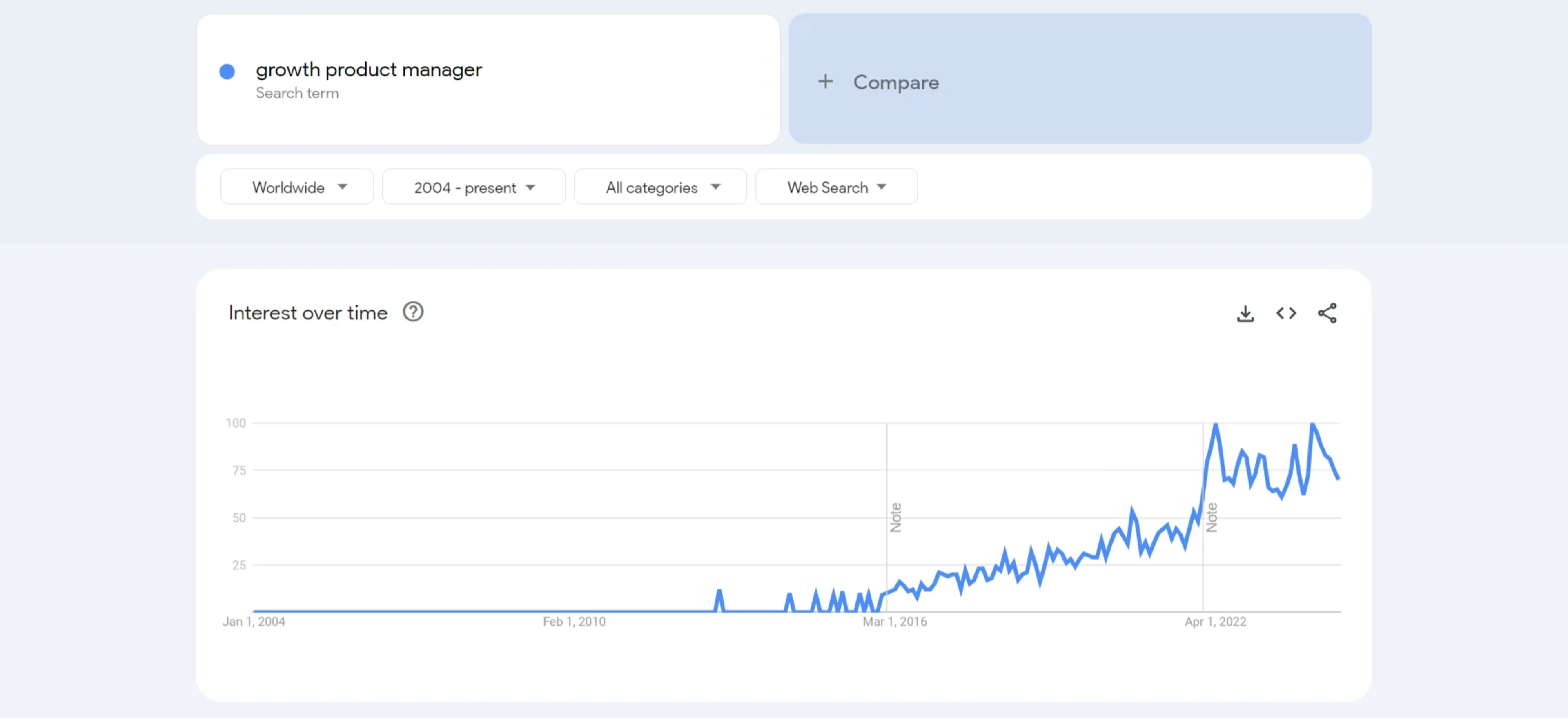Growth product managers (or growth PMs) are in demand, as more companies invest in growth initiatives.
In this guide, we break down what growth PMs do, the skills they need, and the impact they have on a business—so you can learn what it takes to be an effective growth product manager, and understand if hiring one is right for your team.
Summary
A growth product manager is responsible for driving product growth and identifying and improving key metrics while balancing customer and meeting business outcomes. The primary goal of a growth PM is to increase product usage and revenue through incremental product updates.
Key responsibilities of growth PMs:
Understanding user behavior
Optimizing the product for customer and business needs
Collaborating across teams to prioritize the product roadmap
A growth PM’s skill set includes
Product management experience
Data-driven and analytical mindset and
Strong communication skills
Companies should hire growth PMs because their holistic understanding of the product, business goals, and users, which lets them effectively influence the product roadmap for growth
What is a growth product manager?
A growth product manager drives product growth by identifying and improving key metrics and balancing customer and business needs.
The role of growth product manager sometimes goes by other job titles, including:
Product Manager, Growth
Product Growth Manager
Manager, Product Growth
Senior Growth Product Manager
Lead Product Manager, Growth
Senior Product Manager, Growth

Same job, many names
Essentially, these roles all share the same goal: growing usage and revenue by making incremental product updates.
Growth product managers vs product managers
Growth product managers are specialist product managers:
Product managers drive and prioritize the product roadmap by balancing business and customer needs in general
Growth product managers do the same, but focus on optimizing for product-led growth so that the product itself attracts and retains customers
Growth product managers measure success by tracking key growth metrics like
Time to value (TTV): how long it takes users to get value from a product
Customer retention: the rate at which customers continue to do business with a company over time
Free trial conversion rate: the number of users who become paying customers during a free trial period
Customer Effort Score (CES): the effort it takes users to complete an action e.g. upgrading to a paid account
There’s still plenty of overlap in the daily responsibilities of traditional product managers and growth PMs, and the size of the company and team you work in will impact how narrow or broad the role of growth PM is.
3 key responsibilities of growth product managers
Growth product managers have three core responsibilities:
Understanding user behavior
Optimizing the product for customer and business needs
Collaborating across teams to prioritize the product roadmap
1. Understanding user behavior
A growth PM’s job starts with understanding users and customers. They keep a finger on the pulse on what’s happening in a product by looking at data from product growth tools, including
Product analytics tools to track quantitative product and business metrics like LTV (customer lifetime value) and customer retention rate
Product experience tools, like Session Replay or Heatmaps, to spot problems, bugs, and user pain points
User Voice of Customer tools, like AI-Powered Surveys, Unmoderated Testing, and Interviews to collect product feedback from real users
"
We use Session Replay to understand the behavior of our users, identify issues or bugs in our product flows, assess the UX of new product or feature launches, and compare different versions of a page or product area whenever we run any A/B tests.
Andrei Beno
Senior Director of Product (Growth) at Contentsquare
![[Visual] Session Replay | Error Details](http://images.ctfassets.net/gwbpo1m641r7/5DZbkzo3qFEHFqYFZ7eKsE/755984f322cabf5a7554ccbf5c244e6c/Screenshot_2024-11-04_at_21.10.30.png?w=3840&q=100&fit=fill&fm=avif)
Contentsquare’s Session Replay shows you how users experience your onboarding process and product
2. Optimize the product for customer and business needs
By combining user research with business insights—from metrics like customer acquisition cost (CAC), activation rate, and retention rate—growth PMs can move on to their next responsibility: identifying growth opportunities and creating hypotheses for optimization experiments.
Growth PMs use tools like Product Analytics to A/B test changes and incrementally roll out product updates. Ideas for tests come from a range of tools and sources:
Feedback (collected via Contentsquare’s Voice of Customer) gives users and customers the chance to tell you what they love (and hate)
Journey Analysis lets you see how user progress through your site letting growth PMs find points in the user journey with steep drop-offs
Heatmaps show if key CTAs are getting clicked
Session Replay reveals the bugs and issues holding users back
See Journey Analysis in action: the GoPro team used Contentsquare’s Journey Analysis to deeply understand visitor engagement and conversion on their ‘Hero7’ product detail page.
By analyzing metrics such as Engagement, Attractiveness Rate, and Click Rate, they were able to confidently redesign the page with rich, interactive content, resulting in an 80% increase in conversions from the product detail page.
![[visual] journey-analysis](http://images.ctfassets.net/gwbpo1m641r7/323APYc3YVNqFcGXJYQoEK/f61882703037ffc91787d921fcadebc0/journey-analysis.png?w=3840&q=100&fit=fill&fm=avif)
"Contentsquare has made our lives so much easier — not only can we see how each element of content performs, it also shows us how visitors journey through the site, giving us all the information we need to make decisions confidently. "Eumir Nicasio - Head of Product, Digital & eCommerce @ GoPro
3. Collaborating across teams to prioritize the product roadmap
"
My team’s responsible for growth and user acquisition, which means we need to collaborate closely with our marketing, content, sales, and other product teams.
Andrei Beno
Senior Director of Product (Growth) @ Contentsquare
Growth product managers have to collaborate with stakeholders from marketing, engineering, design, and leadership teams to get buy-in for, prioritize, and execute product updates.
Product prioritization and management tools, like Productboard and Jira, help growth PMs plan, manage, and prioritize the product roadmap, and communicate strategy and outcomes across the org.
See it in action: when our growth PMs run an A/B test or experiment at Contentsquare, they use our own Heatmaps and Session Replay tools to identify issues and assess how a new feature variation is performing. Then they share relevant recordings and heatmaps with the team.
3 core skills a growth PM needs to demonstrate
Most companies ask for three core skills from a growth product manager:
Product management experience
Data-driven and analytical mindset
Strong communication skills
1. Product management experience
Most open growth PM roles require between 2 and 7 years of product management experience.
If you’re new to product management, marketing/product marketing experience is highly transferable, with lots of skill overlap (e.g. building roadmaps, cross-functional team collaboration, user research).
An understanding of product design methodologies, like design thinking and agile product management, will also help you transition into a PM role.
Most companies also like candidates to know the industry or sector they’ll be working in. For instance, if you’re looking to be a growth PM at Contentsquare, experience at another B2B SaaS (software-as-a-service) company will be useful.
2. Data-driven and analytical mindset
Growth PMs have to be comfortable collecting, analyzing, and reporting on a lot of data, both quantitative and qualitative, to make informed decisions that enhance customer experience.
Rather than guessing what might be holding users back from converting, growth product managers will study user data and analyze funnels to find issues, A/B test solutions, and measure results using key metrics like free trial conversion rate and expansion MRR.
Experience using popular product tools like Contentsquare and Jira is desirable.
3. Strong communication skills
To be successful, growth product managers need strong communication skills to interact with teams, stakeholders, and users. Growth PMs need strong verbal (in meetings and presentations) and written (via reports, email, and async messages) communication skills, and the ability to use visual media like whiteboards, process flows, and sketches where necessary.
If you’re becoming a growth PM in a fully-distributed or remote team, like we are here at Contentsquare, strong communication skills are even more important to ensure your teammates are kept in the loop and know what's important, wherever in the world they might be.
Why companies need growth PMs
"
The rise of growth product management has come with the popularity of product-led growth: as more companies pursue it, they realize that product managers have enough on their plates and shouldn’t have to be responsible for driving both product development and product demand.
Laura Wong
Former Associate Growth Product Manager at Hotjar
By shifting growth away from sales and marketing and toward product teams, companies can benefit from a growth PM’s unique understanding of the product, business goals, and users: they are holistic product experts and therefore perfectly positioned to influence the product roadmap to achieve growth.
That’s why the role of growth product manager has become more popular in many sectors, including B2B, ecommerce, insurance, healthcare, subscription, and, most commonly, software, coinciding with an increase in product-led growth strategies.

Search interest in the term “growth product manager” has grown quickly
You only need to look at companies recently employing growth PMs (links go to relevant, archived job listings) to see how this role has started to become crucial for many business types:
Adobe: creative and document management software
Zoom: video conferencing platform
Yelp: business directory
BlueApron: meal kit service
Goody: gift-sending service
MaintainX: business operations software
Delta Dental: dental insurance company
Fame & Partners: clothing company
Noom: subscription health app
Quorum: public affairs software
Upkept: home maintenance app
Next steps for your product growth team
Adding a growth product manager to your team could really move the needle if you’re working on customer-facing challenges like acquisition, onboarding, engagement, and retention. Read more about what growth PMs can achieve in our guide to growth product management.
And if you’re looking to get hired as a growth product manager, you can
Start using Contentsquare where you’re currently working, to collect insight and better understand user behavior
Tune into our free webinars to level up your skills
See if we’re hiring for any growth product manager roles at Contentsquare 😉
Growth product manager FAQs
What does a growth product manager do?
Growth product managers drive growth by identifying and improving key product metrics and KPIs and balancing customer and business needs while collaborating across product, marketing, and engineering teams.
What tools does a growth product manager use?
Growth product managers need to use a wide range of product tools to understand customers and usage trends, run experiments, manage product roadmaps, and coordinate and communicate updates across teams. Some of the most popular tools you’ll find on job listings include:
Google Analytics
Contentsquare
Jira
What salary does a growth product manager earn?
Growth product managers can earn an average annual salary of anywhere between $75,000 and $200,000 depending on experience, seniority, and the scope of the role.
